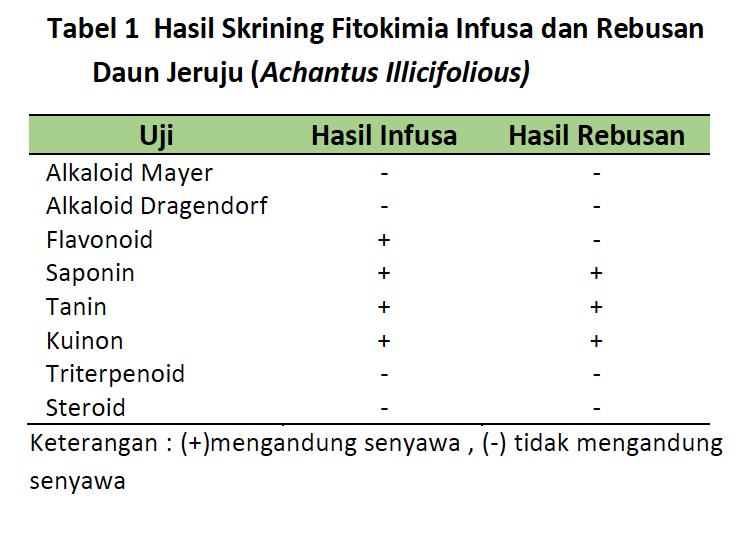Antibacterial Activity Test of Decoction and Infusion of Jeruju Leaves (Achantus illicifolious) Against Methicilin Resistant Staphylococcus aureus (MRSA) Bacteria
DOI:
https://doi.org/10.36733/usadha.v3i1.7222Keywords:
achantus illicifolius, MRSA, infusion, decoctionAbstract
Infectious diseases are still a health problem throughout the world, including in Indonesia. One cause of infection that needs to be watched out for is resistance to Methicillin-Resistant Staphylococcus aureus (MRSA) bacteria. Continuous use of antibiotics can cause problems with microbial resistance. Indonesia has various plant species that can actually provide benefits but have not been specifically cultivated. Jeruju leaves (Achanthus ilicifolius) from mangrove plants contain bioactive compounds that have the potential to be antibacterial. The aim of this research is to determine the antibacterial activity of Jeruju leaf decoction and infusion against MRSA bacteria. Antibacterial activity testing uses MRSA bacteria. The results of the phytochemical screening of Jeruju leaf infusion contained secondary metabolite compounds in the form of flavonoids, tannins, saponins and quinones. Meanwhile, the results of the phytochemical screening of Jeruju leaf decoction contained secondary metabolites in the form of tannins, saponins and quinones. Based on the results of research conducted on infusions and decoctions of Jeruju leaves at concentrations of 30%, 60% and 90%, they did not have inhibitory power on the antibacterial activity of MRSA, as seen from the inhibition zone. Zero inhibition zone for MRSA bacteria. It can be concluded that the infusion and decoction of Jeruju (Achantus illicifolious) leaves do not have antibacterial activity against MRSA.
References
Ernianingsih, S. W., Mukarlina, & Rizalinda. (2014). Etnofarmakologi Tumbuhan Mangrove Achantus ilicifolius L ., Acrostichum speciosum L . dan Xylocarpus rumphii Mabb . Di Desa Sungai Tekong Kecamatan Sungai Kakap Kabupaten Kubu Raya. Protobiont, 3(2), 252–258.
Manilal, A., I.S. Sujith, G.S. Kiran, J. Selvin, and C. Shakir. 2009. Biopotentials of mangroves collected from the Southwest Coast of India. Glo. J. Biotechnol. 4(1):59-65
Manimozhi, D. M., S. Sankaranarayanan and G. Sampathkumar. 2012. Evaluating the antibacterial activity of flavonoid extracted from Ficus benghalensis. International Journal of Pharmaceutical and Biological Research. Vol. 3 (1).
Faidiban AN, Posangi J, Wowor PM, dan Bara RA, 2020. Uji Efek Antibakteri Chromodoris annae terhadap Bakteri Staphylococcus aureus dan Escherichia coli. Medical Scope Journal (MSJ), 1(2): 67–70.
Kusmiati, K., Priadi, D., & Rahayu, R. K. (2017). Antibacterial Activity Test, Evaluation of Pharmacognosy and Phytochemical Screening of Some Extracts of Globe Amaranth (Gomphrena globosa). The Journal of Pure and Applied Chemistry Research, 6(1), 27. Institute for Health Metrics and Evaluation. Global Burden Disease (GBD) Compare. Published 2013. Accessed June 21, 2015. http://vizhub
Ulya, N. (2019). Pengaruh konsentrasi dan lama perendaman larutan infusa daun salam (Syzygium polyanthum) terhadap total bakteri Staphylococcus aureus, Escherichia coli, Salmonella sp., dan kadar protein pada daging ayam (Doctoral dissertation, Universitas Islam Negeri Maulana Malik Ibrahim).
Hidayat, S. (2015). Uji Aktivitas Antibakteri Infusa Daun Mangga Bacang (Mangifera foetida L.) Terhadap Staphylococcus aureus Secara In Vitro. Jurnal Mahasiswa PSPD FK Universitas Tanjungpura, 3(1).

Downloads
Published
Issue
Section
License
Copyright (c) 2024 Penulis

This work is licensed under a Creative Commons Attribution-NonCommercial 4.0 International License.




